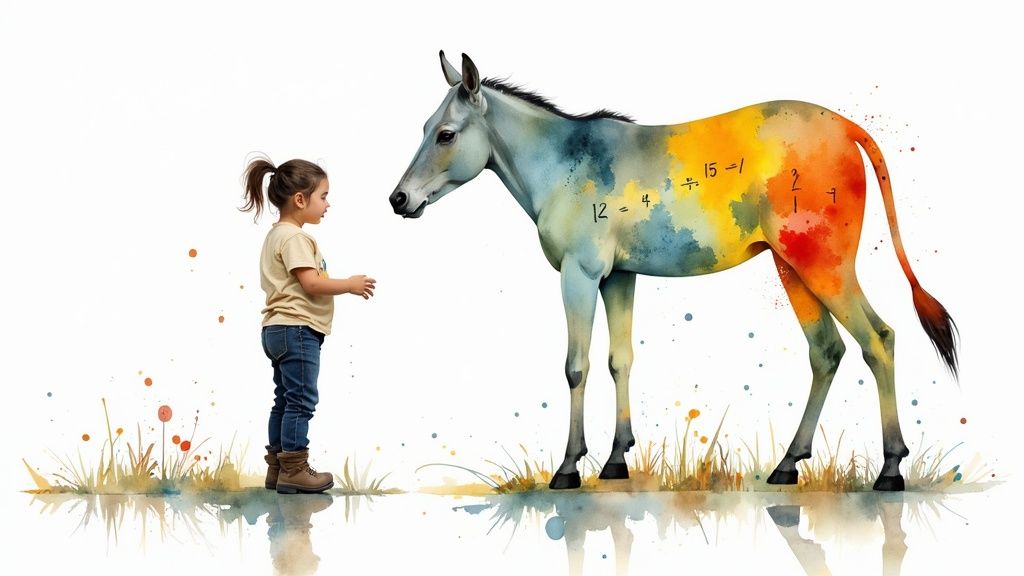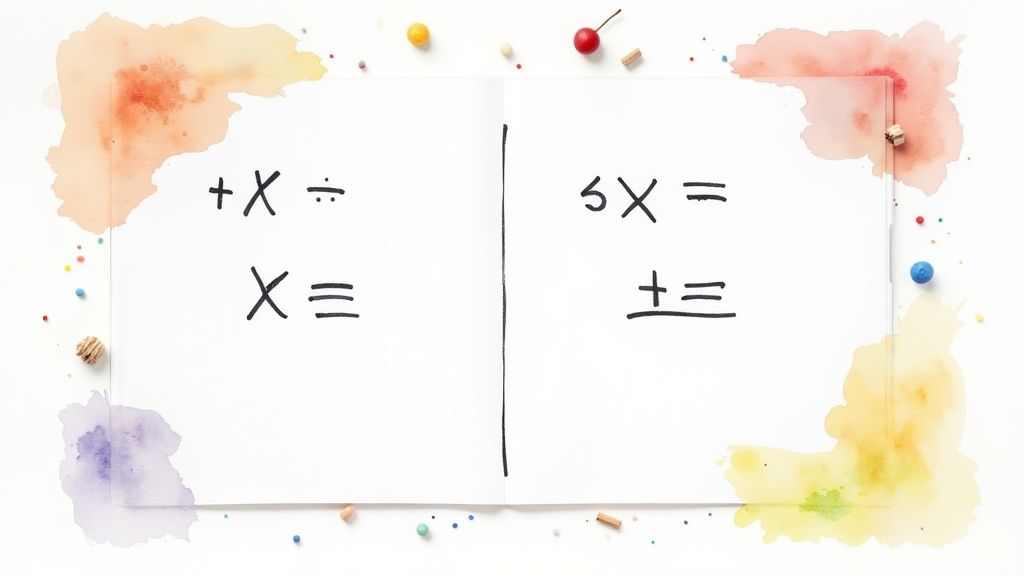Math Coloring Worksheets Printable: Free & Fun!
March 12, 2025

Unleash the Power of Color: Printable Math Worksheets for Kids
Let's face it, math can be a challenge. Many kids (and adults!) find traditional math drills tedious. But what if learning math could be a vibrant, engaging, and even fun experience? That's where the power of math coloring worksheets comes in. These printable resources combine the joy of coloring with fundamental math concepts, creating a learning experience that's both effective and enjoyable.
Math has always been essential for understanding our world, from basic counting to complex equations. While teaching methods have evolved – from ancient abacuses to modern digital tools – core principles remain the same. Effective math education builds a solid foundation, layer by layer, making complex concepts accessible through practice and visualization.
This is where coloring excels. By connecting visual cues (colors) with mathematical concepts, these worksheets engage a different part of the brain, boosting engagement and memory retention. They transform math time from a chore into a colorful adventure, benefiting learners of all ages and skill levels.
Exploring the Spectrum of Math Coloring Worksheets
These versatile worksheets cover a wide range of math topics:
- Basic Arithmetic: Coloring activities reinforce addition, subtraction, multiplication, and division facts.
- Fractions and Decimals: Visual representations help learners grasp these sometimes tricky concepts.
- Geometry: Coloring shapes and patterns introduces geometric principles in a hands-on way.
- Problem Solving: Color-by-number puzzles incorporate word problems, making problem-solving more engaging.
The Benefits of Coloring for Math Learning
- Increased Engagement: The act of coloring makes learning math more interactive and enjoyable.
- Improved Memory Retention: Visual and kinesthetic learning styles are activated, enhancing memory.
- Reduced Math Anxiety: Coloring provides a relaxing and low-pressure environment for learning.
- Creative Expression: Students can personalize their work, fostering creativity and self-expression.
- Accessibility: Printable worksheets are readily available and affordable, making them accessible to a wide audience.
Prepare to unlock a world where numbers meet art, and learning comes to life!
1. Multiplication Color By Number
Multiplication Color By Number worksheets offer a fun, creative way to reinforce multiplication skills. These worksheets feature a picture broken down into sections, each containing a multiplication problem. Kids solve the problem and then color the section based on the corresponding answer key. As they work through the problems, a vibrant image emerges. This blend of coloring and math makes practicing times tables far more enjoyable than traditional drills.

These worksheets cater to a wide range of abilities, from simple multiplication facts to more complex multi-digit problems. The variety of themes, like animals, holidays, and seasonal images, also helps maintain children's interest. The self-checking aspect is a significant advantage. An incorrect answer will result in an obvious coloring mistake, prompting children to self-correct and identify areas where they need more practice. This visual feedback is invaluable for reinforcing learning.
Multiplication Color By Number worksheets are incredibly adaptable and complement different multiplication strategies. Whether a child prefers skip counting, using arrays, or memorization, these worksheets can provide valuable support. Additionally, their availability in both black and white printable formats makes them accessible to all. For optimal printing results, check out our guide on printing coloring pages.
Pros and Cons of Multiplication Color By Number
Let's examine some advantages and disadvantages:
Pros:
- Engaging and fun: Math practice becomes enjoyable and less of a chore.
- Creative outlet: Combines math with artistic expression.
- Instant feedback: Provides immediate visual feedback.
- Appeals to different learning styles: Caters to visual and kinesthetic learners.
- Encourages completion: Motivates kids to finish to reveal the picture.
Cons:
- Time-consuming: Can take considerable time, especially for complex images.
- Repetitive for advanced learners: May not be challenging enough for some.
- Requires supplies: Colored pencils or markers are needed.
- Limited scope: Primarily reinforces existing concepts.
Real-World Applications and Implementation Tips
Real-world examples:
- Elementary teachers utilize them in math centers.
- Homeschooling parents use them for supplemental practice.
- They're effective as engaging homework alternatives.
Tips for Implementation:
- Laminate worksheets for reuse with dry erase markers.
- Begin with simpler problems before progressing to more complex ones.
- Use them for informal assessment.
- Offer them as early finisher activities or homework.
The increasing popularity of Multiplication Color By Number worksheets is due in part to resources like Math Geek Mama and creators on Teachers Pay Teachers. Their inclusion in curricula, such as the Common Core, has further cemented their value as a tool for making math more fun and approachable.
2. Addition and Subtraction Color by Code

Addition and Subtraction Color by Code worksheets offer a fun, engaging way for elementary students to practice math. Instead of rote memorization, children solve problems to create colorful pictures. Each section of the worksheet presents a math problem, and the answer corresponds to a color on a provided key. By solving the problems, students reveal the colors needed to complete an image, perhaps a holiday scene, an animal, or a seasonal design.
This interactive approach makes learning math less intimidating. The immediate visual feedback helps children see if their answers are correct, reinforcing their understanding of addition and subtraction. The coloring aspect adds a creative element, potentially reducing math anxiety and making the learning experience more enjoyable. For more insights into this kind of learning, explore examples of learning through play: Learning Through Play Examples.
A key advantage of these worksheets is their versatility. They offer various difficulty levels, progressing from single-digit operations to multi-digit problems, sometimes even incorporating regrouping (carrying and borrowing). This adaptability allows educators and parents to tailor the worksheets to a child's specific skill level, whether they are just beginning addition or tackling more complex subtraction.
These worksheets have gained popularity, thanks in part to educational websites like Education.com and Super Teacher Worksheets. Even first-grade teacher influencers on social media have shared their creative uses. The worksheets have become a classroom staple for first and second grade, used in math centers, as early finisher activities, or assigned as homework. They are also valuable tools in intervention programs, helping struggling math students build skills in a supportive environment.
Pros and Cons of Color by Code Worksheets
Pros:
- Combines math skills with a creative activity.
- Provides instant visual feedback.
- Builds number sense and operational fluency.
- Reduces math anxiety.
- Adaptable to various skill levels.
Cons:
- May not sufficiently challenge advanced students.
- Can be difficult for colorblind students.
- More effective for reinforcement than teaching new concepts.
- Requires colored pencils or crayons.
Tips for Implementation
- Pre-teach the Concept: Ensure children understand the color key before working independently.
- Collaborative Learning: Encourage small groups of mixed ability students to work together.
- Use Transparent Counters: These tools can help students check their work.
- Durable Worksheets: Print on cardstock for longevity.
- Classroom Displays: Showcase completed worksheets to celebrate achievements.
This method adds a playful element to math practice, making it more positive and engaging for young learners. The adaptability across skill levels and the immediate feedback it offers make it an effective tool for reinforcing addition and subtraction skills.
3. Fraction Operation Math Coloring Puzzles
Fraction operations can be a real challenge for upper elementary and middle school students (typically grades 5-7). Fraction Operation Math Coloring Puzzles offer a fun and engaging way to tackle these tricky concepts. They cleverly blend art and math, turning what can be a dreaded topic into an enjoyable activity.
How do these puzzles work? Students solve a series of fraction problems. Each answer corresponds to a color on a key (for instance, 1/2 might be blue, 2/3 green, etc.). As they solve the problems and color the corresponding areas, a picture begins to emerge, rewarding their efforts.
These puzzles go beyond simple entertainment. They transform abstract fraction operations into concrete, visual experiences. Imagine trying to picture adding 1/4 + 1/2. These puzzles make this process tangible, allowing students to see how the fractions combine to create a portion of the image.
Key Features of Fraction Operation Math Coloring Puzzles
- Fraction Operation Focus: The puzzles cover addition, subtraction, multiplication, and division of fractions with both like and unlike denominators.
- Appropriate Challenge Level: Mixed numbers and improper fractions add complexity suitable for upper elementary and middle school students.
- Engaging Designs: The puzzles feature intricate designs that appeal to older learners, moving beyond simpler, childish images.
- Emphasis on the Entire Process: Simplifying answers is a key part of completing the puzzles.
- Targeted Practice Options: Worksheets focusing on specific operations or mixed operations allow for customized practice.
- Built-In Self-Assessment: The final picture acts as a self-check. If the image doesn't look right, students know they need to review their calculations.
Pros and Cons of Using Coloring Puzzles
Let's take a look at the advantages and disadvantages of incorporating these puzzles into your teaching toolkit.
| Pros | Cons |
|---|---|
| Makes fractions more engaging and less intimidating | Requires basic fraction understanding |
| Reinforces the complete fraction process | Can be time-consuming |
| Encourages accuracy through self-checking | Might frustrate students significantly struggling with fractions |
| Combines analytical and creative thinking | Best for practice and reinforcement, not initial instruction |
Real-World Examples and Implementation
Fraction Operation Math Coloring Puzzles are used in classrooms and homes. They're integrated into 5th-7th grade math lessons on fractions, used as enrichment for advanced math students, and employed as review tools before tests. Homeschooling families also find them beneficial for reinforcing fraction skills. Resources for these puzzles are widely available online, popularized by websites like Math Crush and Math Geek Mama, as well as numerous teachers sharing materials.
Tips for Maximizing Effectiveness
Here are a few tips to get the most out of these puzzles:
- Offer fraction models or manipulatives to students who need extra help.
- Encourage peer learning through partner work.
- Use completed puzzles as assessment tools.
- Create a gallery walk to display the finished artwork.
- Consider digital tools for pre-coloring checks.
Fraction Operation Math Coloring Puzzles earn their place on this list because they present a unique and effective approach to learning fractions. They connect abstract concepts with concrete understanding, transforming fraction practice from a chore into a captivating activity. The fusion of analytical math with creative expression makes learning fractions a more enjoyable and rewarding experience.
4. Geometry and Shapes Color by Math Properties

Want to inject some fun into learning geometry? "Geometry and Shapes Color by Math Properties" worksheets offer a creative blend of art and math. These engaging printables challenge students to color sections of shapes based on their geometric properties. This might involve calculating area and perimeter, identifying angles, or even plotting coordinates. It's a brilliant way to make abstract geometric concepts more tangible.
Instead of simply memorizing formulas, students actively apply them. They could color a triangle with an area of 10 square units blue, or a rectangle with a perimeter of 20 units green. This visual, hands-on approach strengthens spatial reasoning and helps solidify those formulas. Geometry transforms from a series of equations into a dynamic exploration of shapes and their characteristics.
These worksheets also naturally introduce and reinforce key geometry vocabulary. Kids encounter terms like vertices, edges, and faces within the context of the activity. They're not just learning definitions; they're seeing these elements in action.
Why These Worksheets Are Effective
These worksheets go beyond simple coloring; they promote learning by doing. This active engagement is essential for comprehension and retention. The combination of visual, kinesthetic, and logical learning also caters to diverse learning styles. Whether your child learns best visually or prefers a hands-on approach, these worksheets offer a multi-sensory experience.
Features and Benefits
- Vocabulary and Property Focus: These worksheets cover a wide range of concepts, from basic shape recognition to more advanced calculations. They help students understand essential geometric terms and properties.
- Calculation Integration: Area, perimeter, and even volume are all incorporated. Worksheets can include calculations for both 2D and 3D shapes, helping students practice those important formulas.
- Angle Activities: Measuring and classifying angles becomes an interactive coloring exercise, making this sometimes difficult concept more approachable.
- Coordinate Geometry Options: Some worksheets integrate coordinate geometry, allowing students to plot points and connect them to form shapes.
Pros and Cons
Pros:
- Improves visual-spatial skills and reinforces numerical calculations
- Makes abstract geometric concepts more concrete and understandable
- Builds mathematical vocabulary organically
- Provides an enjoyable and engaging way to learn geometry
- Adaptable for various grade levels
Cons:
- May require more teacher explanation than simpler coloring pages
- Often requires additional tools like rulers and protractors
- Can be challenging to differentiate for varying skill levels
- Fewer readily available options compared to operation-based coloring worksheets
Real-World Applications and Examples
- Middle School Geometry: Reinforcing formulas and concepts
- Elementary Classrooms: Introducing shapes and their properties
- Art and Math Projects: Connecting the two disciplines creatively
- STEM Programs: Highlighting the importance of math in design and architecture
Tips for Implementation
- Pre-teach Vocabulary: Introduce key terms before starting the activity.
- Provide Formula Sheets: A quick reference sheet can be very helpful, especially for complex calculations.
- Create Anchor Charts: Visual aids can support student understanding.
- Collaborative Activities: Encourage group work and discussions.
- Real-World Connections: Discuss how geometry applies to architecture, design, and other fields.
The increasing popularity of these worksheets is due in part to resources like Math-Drills.com, Scholastic teaching resources, and activities recommended by the NCTM (National Council of Teachers of Mathematics). These organizations recognize the value of combining visual learning with mathematical practice. So, gather some colored pencils and prepare to explore the vibrant world of geometry!
5. Decimal and Place Value Color-by-Solution
Decimal and Place Value Color-by-Solution worksheets offer a fun, engaging way to practice decimal skills. These activities transform traditional math drills into a colorful, picture-based learning experience. Instead of just solving problems, students create a vibrant image based on their answers, making learning about decimals much more visually appealing.
These worksheets typically involve a set of decimal problems, ranging from basic addition and subtraction to more challenging multiplication and division. Students solve each problem, and then color designated sections of the worksheet according to their answers. As they work, a colorful picture gradually emerges. It's like a mystery image revealed through decimal mastery.
Why These Worksheets are Effective
Decimals can be a challenging concept for many students. They add a new layer of complexity to numbers, and the abstract nature of place value can be difficult to grasp. Color-by-solution worksheets help by making decimals more concrete and visual. The coloring process provides immediate feedback, allowing students to quickly identify and correct mistakes, reinforcing their understanding.
Features and Benefits
-
Variety of Concepts: These worksheets cover a broad range of decimal concepts, from basic place value to more complex operations like multiplication and division. They can be adapted to suit different skill levels and often incorporate real-world applications, such as money calculations or metric measurements.
-
Engaging and Motivating: The coloring element adds an aspect of fun and creativity. The anticipation of the final image keeps students motivated and focused, even with challenging problems.
-
Connecting Fractions and Decimals: Many of these worksheets include activities that involve converting between fractions and decimals. This strengthens the important connection between these two key concepts.
-
Immediate Feedback: The coloring process offers instant feedback. If a section ends up the wrong color, students know immediately that they need to double-check their work.
Pros & Cons
-
Pros: Provides a visual representation of decimals, offers instant feedback, connects fractions and decimals, builds fluency, incorporates real-world contexts.
-
Cons: Can be difficult for beginners and may require initial teacher guidance. Worksheets can sometimes feel overwhelming if too cluttered, and they generally focus on practice rather than initial concept introduction.
Practical Tips for Using These Worksheets
-
Visual Aids: Offer tools like decimal grids or base-ten blocks to provide extra visual support for students who need it.
-
Gradual Progression: Start with simpler operations like addition and subtraction before introducing more complex concepts.
-
Real-World Connections: Whenever possible, connect decimal problems to everyday situations, such as shopping, measuring ingredients, or tracking sports statistics.
-
Assessment Tool: Use these worksheets as formative assessments to identify areas where students may need extra help.
-
Differentiation: For students who are struggling, offer partially completed versions or reduce the number of problems.
Growing Popularity and Examples in Action
Websites like Math-Aids.com and the increasing availability of resources aligned with the Common Core have boosted the popularity of these worksheets. Math teacher bloggers, especially those focusing on upper elementary math, have also played a significant role in sharing creative ideas and free printable resources. Here are a few examples of how these worksheets are used:
- 4th-6th Grade Classrooms: Used to reinforce key decimal concepts during decimal units.
- Financial Literacy Programs: Used to help students practice decimal calculations in the context of money.
- Measurement Units: Used to reinforce decimal concepts within metric system activities.
- Remediation Programs: Used to provide targeted practice for students struggling with decimals.
By blending the challenge of decimal operations with the fun of coloring, these worksheets offer a powerful way to make math more engaging and accessible for students of all levels.
6. Algebra Equations and Expressions Coloring Activities
Let's be honest, algebra can sometimes feel a bit dry and abstract. Algebra Equations and Expressions Coloring Activities offer a fun, visual way to learn. These advanced math coloring worksheets, ideal for upper elementary and middle school students, transform solving equations and evaluating expressions into a colorful adventure. Instead of just number crunching, students use their solutions to color parts of a design, making algebra practice more engaging and visually rewarding.
So, how do these activities work? They involve solving one and two-step algebraic equations and evaluating expressions by substituting variable values. More challenging versions even include systems of equations. These activities reinforce crucial skills like order of operations with variables, function tables, input/output relationships, and pattern recognition.
The strength of these worksheets lies in their ability to introduce algebraic thinking in an accessible format. They build confidence in working with variables and equations, providing immediate visual feedback when a solution is correct. This instant gratification helps solidify understanding and creates a meaningful context for checking answers. It's a great way to bridge the gap between arithmetic and algebraic thinking.
For instance, picture a coloring sheet with a robot. Each section is labeled with an algebraic equation or expression. Students solve the problems, and the answers correspond to specific colors. A correct solution might indicate the robot's head should be blue, while an incorrect one could lead to a mismatched color, prompting the student to review their work.
Of course, these worksheets have their challenges. They can be difficult for students still learning the basics of algebra and require a good grasp of operations and order of operations. The designs are also often less whimsical than simpler math coloring sheets for younger learners. Finding algebra-focused coloring resources can also sometimes be more difficult compared to arithmetic options.
Despite these limitations, Algebra Equations and Expressions Coloring Activities are a valuable math education tool. Their effectiveness in making algebra accessible and engaging is recognized by teachers, curriculum developers, and math education content creators like Math Giraffe. Teachers often use them in pre-algebra and algebra courses, as transitional activities from arithmetic, and even as differentiated activities for advanced elementary students. They've also been helpful in intervention programs for students struggling with traditional algebra instruction.
To get the most out of these activities, review equation-solving strategies with students before they work independently. Providing reference sheets with algebraic properties and rules can also be beneficial. Encourage collaborative learning by having students work in pairs to discuss strategies and solutions. Start with simpler one-step equations and gradually introduce more complex problems. Finally, connect algebraic expressions to real-world examples students understand. This can make abstract concepts more concrete and relevant.
You might be interested in: Our guide on creating coloring pages for more creative coloring ideas.
These coloring activities aren't just for classrooms; they're also a great resource for parents looking for engaging ways to supplement their children's math education. They provide a creative and personalized learning experience, making algebra more accessible and enjoyable.
7. Holiday and Seasonal Math Coloring Worksheets

Holiday and Seasonal Math Coloring Worksheets offer a fun way to combine math practice with the excitement of holidays and changing seasons. These worksheets definitely deserve a place on this list because they add a festive touch to sometimes tedious math drills. Instead of just numbers, kids work with spooky ghosts for Halloween addition, color turkeys while practicing multiplication for Thanksgiving, or decorate Christmas trees with fractions.
These worksheets cover various math concepts, from simple addition and subtraction to more advanced fractions and geometry. The real value is how they integrate these concepts into holiday-themed designs and word problems. For example, a Valentine's Day worksheet might ask students to solve addition problems to determine how many valentines were delivered, then color the picture accordingly. A fall-themed worksheet could have students calculate the perimeter of a pumpkin patch.
Features of Holiday Math Coloring Worksheets
-
Themed Designs: Expect bright, engaging visuals based on holidays like Christmas, Halloween, and Valentine's Day, plus all four seasons.
-
Variety of Content: Worksheets cater to various math skills and difficulty levels for diverse learners.
-
Holiday Context: Word problems incorporate holiday vocabulary and scenarios, making math more relatable.
-
Special Color Codes: Some use holiday-themed number codes and color schemes for extra fun.
-
Bundled Sets: Seasonal sets provide a ready-made resource throughout the school year.
Pros of Using Holiday Math Coloring Worksheets
-
Increased Engagement: Connecting math to holidays taps into students' excitement and boosts motivation.
-
Variety and Novelty: The changing themes keep math practice fresh and prevent monotony.
-
Cross-Curricular Connections: Worksheets create opportunities to discuss holidays and seasons.
-
Easy Implementation: A convenient, ready-to-use resource for busy teachers and parents.
-
Great for Breaks: These provide low-pressure learning during holiday breaks.
Cons of Using Holiday Math Coloring Worksheets
-
Cultural Sensitivity: Choose inclusive materials that respect all backgrounds and beliefs.
-
Limited Use: Relevance is tied to specific time periods.
-
Potential for Superficiality: Some may prioritize the holiday theme over mathematical rigor.
Examples of How to Use the Worksheets
-
Math Centers: Elementary teachers use them for holiday-themed math centers.
-
Warm-Up Activities: Perfect for morning work or warm-ups leading up to a holiday.
-
Homework Assignments: Parents send them home as light homework during breaks.
-
After-School Programs: Add a seasonal twist to after-school activities.
Tips for Maximizing Impact
-
Build a Library: Collect seasonal worksheets year-round to be prepared.
-
Cultural Awareness: Select inclusive materials.
-
Meaningful Rewards: Use them as rewards while ensuring math practice remains valuable.
-
Student Creativity: Encourage students to design their own worksheets.
-
Hands-on Learning: Pair them with holiday-themed manipulatives or counters.
The popularity of Holiday and Seasonal Math Coloring Worksheets has grown thanks to primary education bloggers, teacher resource websites like Pinterest, and teacher-authors sharing creative ideas. They recognized the value of combining learning with fun, especially for younger students.
7 Printable Math Coloring Worksheets Comparison
| Worksheet Title | Implementation Complexity 🔄 | Resource Requirements ⚡ | Expected Outcomes 📊 | Ideal Use Cases 💡 | Key Advantages ⭐ |
|---|---|---|---|---|---|
| Multiplication Color By Number | Medium – Multi-level problems with self-checking format | Printable PDFs; colored pencils/markers | Engaging multiplication practice with visual feedback | Elementary centers, homeschool activities | Combines math with art; reinforces accuracy |
| Addition and Subtraction Color by Code | Low-Medium – Progressive difficulty with answer keys | Printed sheets; colored tools (crayons/pencils) | Strengthens basic arithmetic and number sense | Early grade classrooms, intervention, early finishers | Fun, immediate feedback, differentiation-friendly |
| Fraction Operation Math Coloring Puzzles | High – Involves complex fraction operations and simplification | Fraction models/manipulatives recommended | Deepens conceptual understanding of fraction operations | Upper elementary/middle school enrichment and review sessions | Concretizes abstract fraction concepts with rigorous practice |
| Geometry and Shapes Color by Math Properties | Medium-High – Multiple geometry calculations requiring additional explanation | Worksheets plus tools like rulers and protractors | Enhances spatial reasoning and mastery of geometric properties | Middle school geometry units, project based learning | Integrates art and math; reinforces vocabulary and formulas |
| Decimal and Place Value Color-by-Solution | Medium – Involves multi-step decimal operations | Decimal models; colored materials; teacher support optional | Improves decimal fluency and connects decimals to real-life contexts | Upper elementary math units, financial literacy programs | Visual reinforcement of decimals with authentic contexts |
| Algebra Equations and Expressions Coloring Activities | High – Requires algebraic thinking and prior knowledge | Prerequisite skills; reference sheets and printed guides | Builds confidence in transitioning from arithmetic to algebra | Pre-algebra/algebra classes in middle school; differentiated work | Engaging introduction to variables and equations with feedback |
| Holiday and Seasonal Math Coloring Worksheets | Low – Thematic and variable across math concepts | Themed printables; standard coloring supplies | Increases engagement through seasonal contexts; reinforces concepts | Seasonal classroom activities, morning work, take-home projects | Festive appeal; versatile use across topics; cross-curricular links |
Color Your Way to Math Success: Download Your Free Printables Today!
We've explored a wide range of math coloring worksheets, from basic addition and subtraction to more advanced geometry and algebra. The fundamental concept is simple: make learning enjoyable! By associating colors with answers, children (and even adults) can grasp mathematical concepts in a more engaging and memorable way. It's important to find the right fit for your learner’s age and individual learning style.
Start with easier worksheets and progressively increase the difficulty as they gain confidence. Learning should be an adventure, not a chore! Adapting these coloring pages is also straightforward. You can adjust the difficulty, introduce new challenges, or even create your own color-by-number keys based on specific topics your learner is currently studying. The possibilities are endless!
Keep an eye out—the world of educational resources is constantly evolving. We're seeing more interactive digital coloring pages, personalized worksheets, and even augmented reality experiences emerging. Who knows what exciting new tools will be available in the future!
Key Takeaways: Making Math Fun with Color
Math coloring pages are versatile, adaptable, and most importantly, effective. They provide a creative, personalized learning experience that can enhance understanding and make math less intimidating. They offer a great way to:
- Boost engagement
- Reinforce concepts
- Personalize learning
- Reduce math anxiety
Unleash Your Creativity With ColorPageAI
Ready to unlock the power of color in math learning? Skip the search for individual worksheets and unleash your creativity with ColorPageAI! Generate unique, personalized math coloring pages in seconds, tailored to any skill level or topic. From a "robot solving fractions" to a "dinosaur doing algebra," the only limit is your imagination.
Start creating your first five free coloring pages now at ColorPageAI and watch the math magic unfold!
Ready to start coloring?
Join ColorPage.ai today and get 5 free credits to create your own custom coloring pages!
Start creating